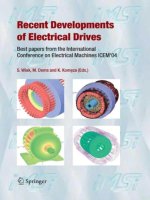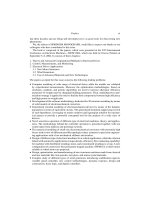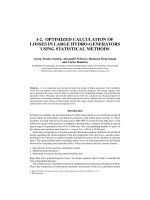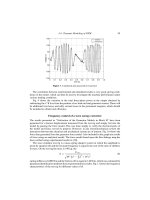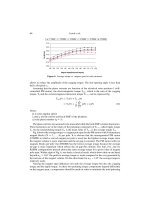Recent Developments of Electrical Drives - Part 9 pps
Bạn đang xem bản rút gọn của tài liệu. Xem và tải ngay bản đầy đủ của tài liệu tại đây (421.97 KB, 10 trang )
66 Lateb et al.
350
370
390
410
430
450
470
120 125 130 135 140 145 150 155 160 165 170 175 180
Magnet Span[Electrical degree]
Tav[kN.m]
1 CSMM 2 RSMM 3 RSMM 4 RSMM 5 RSMM 6 RSMM
Figure 6. Average torque vs. magnet span for each structure.
allows to reduce the amplitude of the cogging torque. The slot-opening angle is less than
half a slot pitch τ
s
.
Assuming that the phase currents are function of the electrical rotor position θ (self-
controlled PM motor), the electromagnetic torque T
em
, which is the sum of the cogging
torque, T
c
and the current-magnets interaction torque T
e−i
, can be expressed by:
T
em
(θ) = T
c
(θ) + T
e−i
(θ)
= T
c
(θ) +
1
q
j=1
i
j
(θ) × e
j
(θ) (12)
where:
is rotor angular speed.
i
j
and e
j
are the current and back EMF of the jth phase.
q is the phase number (q = 3).
The phasecurrents areassumed tobe sinusoidalwhilethe backEMF containsharmonics.
These harmonics are at the origin of the pulsating component of T
e−i
, called ripple torque
T
r
. So the total pulsating torque T
cr
is the mean value of T
e−i
is the average torque T
av
.
Fig.6showstheaveragetorquevs.magnet polespanforthePMmotorswithNelementary
magnet blocks (N = 1,. . . , 6) per pole. It is obvious that the nonsegmented PM motor
(CSMM) in which a curved magnet per pole is used, has the highest average torque since
the magnet volume is more important and the air-gap is constant. The PM motor with two
magnets blocks per pole (two RSMM) has the lowest average torque because the average
air-gap is more important which affects the air-gap flux density. The four, five, and six
RSMM configurations present almost the same average torque for a given value of magnet
pole span. Within sight of Fig. 6, one finds a classical result, which shows that on one hand,
beyond α
m
≈ 165
◦
the profit in average torque is weak compared to the cost generated by
the increase of the magnet volume. On the other hand, for α
m
< 145
◦
the average torque is
relatively weak.
Varying the magnet span influences not only the average torque but also the cogging
torque and the ripple torque. As these two pulsating torque components depend differently
on the magnet span, a compromise should be made in order to minimize the total pulsating
I-6. Design Technique for Reducing the Cogging Torque 67
0
0,1
0,2
0,3
0,4
0,5
0,6
0,7
0,8
0,9
1
120 125 130 135 140 145 150 155 160 165 170 175 180
Magnet Pole Span [Electrical degree]
CTF[%]
1 CSMM 5 RSMM
(a)
0
0,1
0,2
0,3
0,4
0,5
0,6
0,7
0,8
0,9
1
120 125 130 135 140 145 150 155 160 165 170 175 180
Magnet Pole Span [Electrical degree]
CTF[%]
2 RSMM 3 RSMM 4 RSMM 6 RSMM
(b)
Figure 7. Cogging torque factor vs. magnet pole span.
torque T
cr
. In order to carry out a comparative study of various configurations, we use the
next criteria:
CTF =
T
cpp
T
av
; PTF =
T
crpp
T
av
(13)
where CTF and PTF are respectively the Cogging Torque Factor and the Total Pulsating
Torque Factor. T
cpp
and T
crpp
are respectively the peak-to-peak cogging torque and the
peak-to-peak total pulsating torque.
In order to illustrate clearly the effect on the magnets subdivision on the cogging torque,
the results are presented on Fig. 7(a,b). The CTF obtained for the CSMM configuration
(N = 1) presents several minima (Fig. 11a) achieved for the following values of the magnet
pole span: γ =
α
m
1
= (n/2 + 0.17)τ
s
with n = 10 to 14. In [5] the authors have found
α
m
= (n + 0.17)τ
s
. These two results are not in contradiction, because the studied stator
has an odd slot number per pole pair which doubles the number of minima of the cogging
torque.
68 Lateb et al.
Figure 8. Cogging torque waveforms for α
m
= 152
◦
.
For a segmented magnet machine (N = 1) with rectangular magnet blocks (RSMM),
the number of magnet edges per pole pair increases, there is no more universal rule giving
the optimal values of γ =
α
m
N
minimizing the cogging torque. As an example, for the case
(N = 5) presented on Fig. 7(a), the few minima are obtained for either γ =
α
m
5
= (n/2 −
0.17)τ
s
or γ =
α
m
5
= (n/2 + 0.14k)τ
s
with k an odd number.
The results obtained for the other cases (N = 2, 3, 4, and 6) are gathered in Fig. 7(b)
because they present similar shapes. Two common minima are clearly distinguished for the
magnet pole span α
m
≈ 135
◦
and α
m
≈ 152
◦
.
From the investigations presented above, it is clear that one cannot extract a general
rule that reduces the cogging torque rate. However, one can affirm that there is some con-
figurations offering the possibility to reduce considerably the cogging torque as shown in
Fig. 8. Indeed, for α
m
= 152
◦
, the weakest cogging torque is achieved with six RSMM per
pole. However the most important criterion is to maximize the average torque and reduce
as possible the total pulsating torque. So we present in Fig. 9 the total pulsating torque
factor (PTF) evolution vs. the magnets span for different configurations (N = 1, ,6).
The six curves have the same shape but the amplitude of the PTF varies slightly according
to segmentation number N. Referring to Fig. 9, the best choice (PTF ≈ 1.2%) should be
N = 3(α
m
≈ 165
◦
)orN= 4(α
m
≈ 160
◦
). According to Fig. 6 these two configurations
lead nearly to the same average torque but N = 4 corresponds to lower magnet volume.
Even if the most important criterion is to maximize the average torque and to reduce as
possible the total pulsating torque, a special care must be taken to the reduction of lower
torque harmonics (6 and 12). As these harmonics are due the low harmonics (5, 7, 11, and
13) of back EMF, we study in the following the simultaneous effects of the magnet span
and the segmentation in N blocks on their amplitudes.
Fig. 10 presents the magnitude evolution of the main back EMF har monics (7th, 11th,
and 13th). Note that the fifth harmonic of the back EMF is null thanks to the adopted
fractional winding.
For the seventh harmonic, all the curves are almost identical (except for three RSMM
structure), which shows that the segmentation has not a real influence on the seventh har-
I-6. Design Technique for Reducing the Cogging Torque 69
monics. For this latter,the minimum is obtained for a magnetpole span of 155
◦
. The magnet
segmentation seems to have a significant effect on the 11th and 13th harmonics as shown in
Fig. 10(b,c). However, all the curves shown on Fig. 10(b,c) present two minima which do
not coincide with the seventh harmonic one (Fig. 10a). Then to reduce the amplitude of the
sixth torque harmonic, one has to choice a magnet pole span such as the seventh harmonic
of the back EMF is weak compared to 11th and 13th.
Forthestudiedmachinewith anodd number ofslots perpolepair,the choice ofan adapted
winding allows to suppress the fifth EMF harmonic. The choice of an appropriate span
(α
m
≈ 155
◦
) allows to make a good compromise between the increase of the average torque
and the reduction of the sixth torque harmonic. This can be achieved with a segmentation
number N equal to 4, 5, or 6 magnet blocks.
Among these values (N = 4, 5, 6), for the studied machine, the choice of N = 4 leads
not only to the weakest value of the total pulsating torque (Fig. 9) but also to the weakest
value of the cogging torque (Fig. 11).
Taking into account the obtained results in the case of the studied machine, we showed
that the winding type, the stator slots number and the magnet pole span remain the main
parameters acting on the principal performances (Average Torque, sixth torque harmonic)
of the machine. For the appropriate choice of these main parameters, a well-adapted choice
of the segmentation number of blocks allows to reduce the cogging torque and the total
pulsating torque as well.
Conclusion
PM motors are finding expanded use in high power directly driven applications where
torque smoothness is essential. Cogging torque in PM motors is among the undesired
effects contributing to the motor’s output ripple, vibration, and noise. It can be substantially
reduced by the combination of several well-known techniques.
For manufacturing and cost reasons, in large permanent magnet motor, each rotor pole
is often realized with several elementary magnet blocks with the same polarity (magnets
segmentation). In this paper we have shown that the choice of the magnet blocks number
over a pole must be considered as an optimization parameter acting on local phenomena
such as the cogging torque and higher torque harmonics.
0
0,5
1
1,5
2
2,5
3
3,5
4
120 125 130 135 140 145 150 155 160 165 170 175 180
Magnet Pole Span[Electrical Degree]
PTF[%]
1 CSMM
2 RSMM
3 RSMM
4 RSMM
5 RSMM
6 RSMM
Figure 9. Pulsating torque factor vs. magnet pole span.
70 Lateb et al.
0
0,2
0,4
0,6
0,8
1
1,2
1,4
120 125 130 135 140 145 150 155 160 165 170 175 180
Magnet Pole Span[Electrical Degree]
E7/E1[%]
1 CSMM
2 RSMM
3 RSMM
4 RSMM
5 RSMM
6 RSMM
(a)
0
0,1
0,2
0,3
0,4
0,5
0,6
0,7
0,8
120 125 130 135 140 145 150 155 160 165 170 175 180
Magnet Pole Span[Electrical Degree]
E11/E1[%]
1 CSMM
2 RSMM
3 RSMM
4 RSMM
5 RSMM
6 RSMM
(b)
0
0,05
0,1
0,15
0,2
0,25
0,3
0,35
120 125 130 135 140 145 150 155 160 165 170 175 180
Magnet Pole Span[Electrical Degree]
E13/E1[%]
1 CSM M
2 RSM M
3 RSM M
4 RSM M
5 RSM M
6 RSM M
(c)
Figure 10. 7th, 11th, and 13th harmonics back EMF vs. magnet span.
I-6. Design Technique for Reducing the Cogging Torque 71
Figure 11. Cogging torque waveforms for a magnet span corresponding to 155
◦
(electrical degree).
The technique that consists on the choice of an appropriate number of magnet blocks
over a magnet pole cannot be done without considering the main parameters, which impose
the principal machine performances such as the average torque.
In addition to the reduction of the cogging torque and high torque harmonics. Another
important effect of magnet subdivision is to reduce eddy currents inside the magnets. This
may be achieved by the choice of a segmentation number around 6.
References
[1] A. Arkkio, N. Bianchi, S. Bolognani, T. Jokinen, F. Luise, M. Rosu, “Design of Synchronous
PM Motor for Submersed Marine Propulsion Systems”, International Conference on Electrical
Machines (ICEM 2002), Paper No. 523, Brugge, Belgium, August 25–28, 2002.
[2] T.M. Jahns, W.L. Soong, Pulsating torque minimization techniques for permanent magnet AC
motors drives—a review, IEEE Trans. Ind. Electron., Vol. 43, No. 2, pp. 321–330, 1996.
[3] J P. Martin, F. Meibody-Tabar, B. Davat, “Multiple-phase Permanent Magnet Synchronous
Machine Supplied By VSIs Working Under Fault Conditions”, IEEE Industry Applications
Conference, 2000, 35th IAS Annual Meeting, Roma, Italy, October 2000.
[4] L. Parsa, L. Hao, H.A. Toliyat, “Optimization of Average and Cogging Torque in 3-Phase IPM
Motor Drives”, IEEE Industry Applications Conference, 2002, 37th IAS Annual Meeting, Vol.
1, October 13–18, 2002, pp. 417–424.
[5] T. Li, G.R. Slemon, Reduction of cogging torque in permanent magnet motors, IEEE Trans.
Magn., Vol. 24, No. 6, pp. 2901–2903, 1988.
[6] T. Ishikawa, G.R. Slemon, A method of reducing ripple torque in permanent magnet motors
without skewing, IEEE Trans. Magn., Vol. 29, No. 2, pp. 2028–2031, 1993.
[7] K C.Lim,J K.Woo, G H. Kang, J P. Hong,G T.Kim,Detentforce minimization techniques
in permanent magnet linear synchronous motors, IEEE Trans. Magn., Vol. 38, No. 2, pp.
1157–1160, 2002.
[8] S M. Hwang, J B. Eom, Y H, Jung, D W. Lee, B S. Kang, Various design techniques to
reduce cogging torque by controlling energy variation in permanent magnet motors, IEEE
Trans. Magn., Vol. 37, No. 4, pp. 2806–2809, 2001.
[9] D.C. Hanselman, Effect of skew, pole count and slot count on brushless motor radial force,
cogging torque and back EMF, IEE Proc. Electron. Power Appl., Vol. 144, No. 5, pp. 325–330,
1997.
72 Lateb et al.
[10] D. Howe, Z.Q. Zhu, The influence of finite element discretization on the prediction of cogging
torqueinpermanent magnet excited motors, IEEE Trans.Magn., Vol. 28, No. 2, pp. 1080–1083,
1992.
[11] F. Henrotte, G. Deli´ege, K. Hameyer, “The Eggshell Method for the Computation of Elec-
tromagnetic Forces on Rigid Bodies in 2d and 3d”, Proceedings of the 10th Biennial IEEE
Conference on Electromagnetic Field Computation, CEFC’2002, June 2002, p. 30.
[12] D. Meeker, Finite Element Method Magnetics Software, www..
I-7. OVERLAPPING MESH MODEL
FOR THE ANALYSIS OF
ELECTROSTATIC MICROACTUATORS
WITH ECCENTRIC ROTOR
Piotr Rembowski and Adam Pelikant
Institute of Mechatronics and Information Systems, Technical University of Lodz, Poland,
ul. Stefanowskiego 18/22, 90-924 Lodz, Poland
,
Abstract. The numerical model for three-dimensional field analysis of electrostatic micromotors
with stator and rotor symmetr y axes located in the different points has been presented. The results of
the numerical tests confirm the thesis about the correctness of the model. Short CPU time is obtained
even with quite big number of mesh elements.
Introduction
The paper presents numerical model for three-dimensional field analysis of electrostatic
micromotors with stator and rotor symmetry axes located in different points. Due to a very
small size of micromachines it is impossible to place the rotor in such a position that would
provide ideal symmetrical air gap between electrodes. There is no algorithm which fully
covers this kind of asymmetry.Solving this problem through commercial applications leads
to mesh generating for each single analyzed position, which means increased time of the
analysis. The application of the mesh overlapping lets one avoid repeated mesh generating
for the whole model and decrease the time of computation. Reduction of this time can be
obtained by using separated submeshes for both stator and rotor generated only once, and
only recalculating the part describing the air gap.
Possible applications
There are many technical solutions withpurposely designed nonsymmetrical airgap. Oneof
the most important applications is the possibility of using ferroelectrics in the construction
of the wobble motor (Fig. 1). This solution results in a considerable increase of torque. In
this kind of motors the air gap asymmetry is so important that it must not be omitted in
computation.
With the exception of a few approximated analytical modeling cases, there are no known
algorithms for an efficient solution that deals with big asymmetries of the air gap in the
electrostatic microactuators, especially with ferroelectrics.
S. Wiak, M. Dems, K. Kom
˛
eza (eds.), Recent Developments of Electrical Drives, 73–83.
C
2006 Springer.
74 Rembowski and Pelikant
Figure 1. SEM photo of a 100
μ
m-diameter, 2.5
μ
m-gap, wobble micromotor with a free bearing.
A new solution was developed to compute models with nonsymmetrical air gap. This
was possible due to extending mesh overlapping model.
What is more, it is possible to apply the algorithm for models with leant rotor rotation
axis. The sloping can result from technical inaccuracy as well as constr uctor’s intention. So
far the problem of mesh overlapping in all three dimensions has not been so far considered
in literature.
Model
A numerical, finite element method based algorithm has been constructed to solve problems
mentioned above. The integral form of the second Maxwell equation with application of the
Gauss law (1) is a base to formulate mathematical equation describing the analyzed object.
S
(
ε · gradV
)
dS = 0 (1)
The equation (1) applied in finite element method with the approximation on each mesh
element with weigh functions λ
i
leads to formula (2), where V
i
means the values of the
potentials of the nodes.
j
S
j
ε
j
grad
e
λ
i
V
i
dS
j
= 0 (2)
Assuming cylindrical coordinate system, the second deg ree polynomial as approximating
function in a single element was in form (3):
a
0
r(ϑr)z + a
1
r(ϑr) +a
2
(ϑr)z + a
3
rz+ a
4
r + a
5
(ϑr) +a
6
z + a
7
= 0 (3)
I-7. Analysis of Electrostatic Microactuators 75
In the consequence of the above one gets a system of linear equations (4) with symmetric,
well conditioned, positive definite matrix with 27 nonzero elements in each row.
[M]{V }={Q} (4)
Mesh overlapping
In the overlapping mesh model the stator and the rotor are represented by two separate
meshes. An air gap is included in both of them. There is a common region consisting of at
least one common layer along all the height of the model. Values of potentials of peripheral
nodes are determined by boundary conditions and linear approximation based on values
in neighboring nodes of the other mesh. There are two cases of solving the problem: first
when the centers of the stator and the rotor are shifted by a distance which is smaller than
one third of the air gap width (Fig. 2) and the second when the shift is larger (Fig. 3).
In both cases the rotor and stator meshes cover the air gap on the area whose width is
equal to the smallest distance between the rotor and the stator electrodes. In connection
with the above, in the former case both meshes cover the whole area of the air gap and one
single layer of elements (the last one) can be used for mesh overlapping.
In the latter there is a need to extend one of the meshes (by adding additional layers of
nodes) to cover the whole area of the air gap. In this case it is necessary to use more layers
of elements in mesh overlapping computation.
In the symmetrical model both meshes have a common surface, in the air gap area,
along all the height of the model. In this case nodes of the stator and the rotor meshes for
overlapping bounds have only different angle θ (Fig. 4). In this figure nods belonging to the
rotor mesh have numbers starting from the letter i, and nods belonging to the stator mesh
have numbers starting from the letter j. The letters k and n signify the numbers of nodes in
rotor and stator meshes for the constant radius.
Figure 2. Generated meshes for the shit less than one third of the air gap width.

